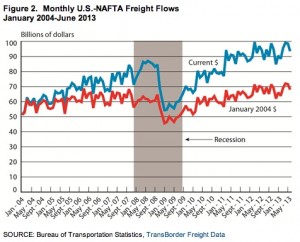
Supply Chain Design Software from LLamasoft
I went to my first SummerCon a few weeks ago (June 13 and 14th). Summercon is the user conference put on by LLamasoft, a provider of supply chain design solutions. LLamasoft has 650 customers who cumulatively have over 7.5 trillion dollars in revenue. Here are my key takeaways from SummerCon 2018:
- There is terrific payback from supply chain design solutions. Vijay Bharadwaj, the Manager Global Logistics Engineering & Strategic Solutions at General Motors, talked about their seven-year journey to optimize network design. At GM, the engineering team is an inhouse consulting group. Annually, the projects they take on save between 5 to 10 percent of the in scope spend. They have done many projects in the logistics area, some on an ongoing basis. Logistics costs as a percentage of revenue decreased every year from 2013 to 2018. That is a remarkable feat in today’s freight environment. Considering the size of GM’s transportation spend, $6.5 billion, and the length of time they have been at this, it would not surprise me at all if this small team has saved GM over a billion dollars.
- Supply chain design can be used to attack a wide range of projects. Most commonly supply chain design is associated with where future warehouses and factories should be built. It is also commonly used to build an optimal transportation network, like at GM. But speakers from Dell talked about using the tools to enable fact-based decisions surrounding component and SKU rationalization. Other speakers addressed using these tools for product procurement optimization, optimizing order allocations, sustainability, and optimally supporting new product introductions.
- Last year LLamasoft introduced Demand Guru. This is a demand modeling tool to help companies develop more customized demand planning solutions. This tool allows a company to more easily clean, blend and then ingest time series data and then test whether that data set improves forecasting over some forecast period or ship to location. Historical third-party data can be imported into the tool and then the company can examine whether their past forecasts could have been improved by using that data set. At this conference, it was announced that Cummins, Gerdau, and Interceramic are all using the tool to improve their strategic forecasting capabilities. This will enable these companies to make better budgeting and capital investment decisions. Most companies’ strategic forecasts use assumptions that are far too simplistic. Making better capital investment decisions can have a huge ROI! This solution is poised to grow very quickly.
- Architecturally, their diverse products are being unified into one cloud-based platform. The platform includes a data management tool for pulling together all the data from diverse systems, validating the quality of that data, and blending the data together. Supply chain design projects require more data from more systems than any other type of supply chain solution. The data collection and validation process actually requires significantly more effort than the analysis does. This is a great tool for companies with a dedicated supply chain design team. The platform also includes a solution for building custom supply chain applications; Meijer used this solution to build their own Transportation Management System.
- This was a fun conference. On a percentage basis, I saw more young people and women at this show than any other supply chain show I’ve attended. LLamasoft, headquartered in Ann Arbor, has a hip, funky culture ideal for smart young millennials.
- This was a bit of a coming out party for the new CEO, Razat Guarav. I’ve known Razat for close to twenty years. He is one of the smartest and hardest working people in supply chain management. Congratulations to LLamasoft for landing him.
This was a great show! I hope to go back next year.





















